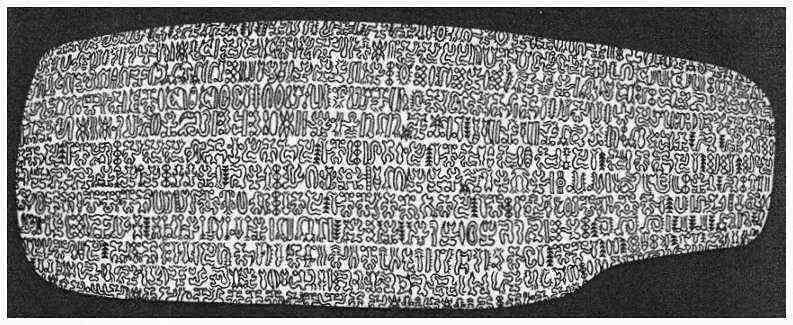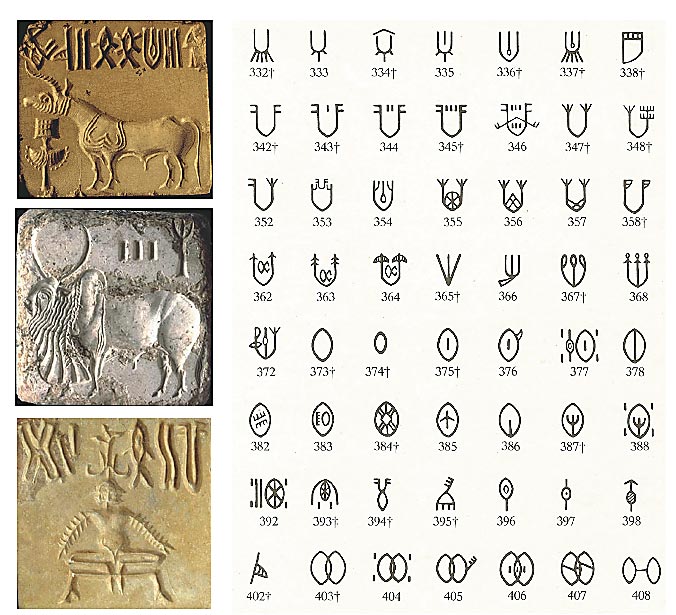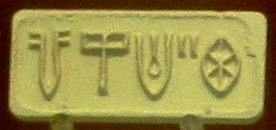It looks like you're using an Ad Blocker.
Please white-list or disable AboveTopSecret.com in your ad-blocking tool.
Thank you.
Some features of ATS will be disabled while you continue to use an ad-blocker.
share:
Can anyone here, offer an explanation for why these two scripts, almost on opposite sides of the world and separated by thousands of years of time
appear to be identical?
a reply to: funkadeliaaaa
Ahh very good lol it does make sense, but at what time period? Were the Indus Valley civilization commuting around the Pacific on boats 3000BC?
Ahh very good lol it does make sense, but at what time period? Were the Indus Valley civilization commuting around the Pacific on boats 3000BC?
I am new to this subject, but what I see of the two scripts, they are not even that similar. Identical would be a real long reach.
a reply to: butcherguy
I know you are not going to look, and the source isn't "reputable" but please look at a book by David Childress - Lost city's of Lemuria. When I first saw what he published I was skeptical also but interested enough so I spent time actually looking for the symbols he published and sure enough they are there. Systematically ticking them off to make sure he wasn't just making it all up.
I know you are not going to look, and the source isn't "reputable" but please look at a book by David Childress - Lost city's of Lemuria. When I first saw what he published I was skeptical also but interested enough so I spent time actually looking for the symbols he published and sure enough they are there. Systematically ticking them off to make sure he wasn't just making it all up.
a reply to: Judgie
I strongly recommend you read the following books (in that particular order) of Thor Heyerdahl:
- Kon-Tiki (he travelled in '48 on a Balsa-wood raft 3000 nautical miles over the pacific to polynesia using just sea-currents)
- Ra (Searching for the oldest sea-going vessel, he undertook two expeditions across the Atlantic in a papyrus-reed boat)
- Mystery on the Maledives (When ancient pyramids where found on the Maldives dating back to literally the Dawn of man, Heyerdahl is invited by the two years ago deposed president/dictator Gamoon to conduct the first archeological dig in the muslim country)
- Early Man and the Sea (this is the most quintessential from these, full of well presented facts(!) that will absolutely blow you away but...trust me, you will thank me if you follow my advice and read them in this order, he was a great explorer and a very entertaining writer).
When you are done, you will know the answer, i dont want to spoil the joy of an epiphany
Peace
I strongly recommend you read the following books (in that particular order) of Thor Heyerdahl:
- Kon-Tiki (he travelled in '48 on a Balsa-wood raft 3000 nautical miles over the pacific to polynesia using just sea-currents)
- Ra (Searching for the oldest sea-going vessel, he undertook two expeditions across the Atlantic in a papyrus-reed boat)
- Mystery on the Maledives (When ancient pyramids where found on the Maldives dating back to literally the Dawn of man, Heyerdahl is invited by the two years ago deposed president/dictator Gamoon to conduct the first archeological dig in the muslim country)
- Early Man and the Sea (this is the most quintessential from these, full of well presented facts(!) that will absolutely blow you away but...trust me, you will thank me if you follow my advice and read them in this order, he was a great explorer and a very entertaining writer).
When you are done, you will know the answer, i dont want to spoil the joy of an epiphany
Peace
originally posted by: Judgie
a reply to: butcherguy
I know you are not going to look, and the source isn't "reputable" but please look at a book by David Childress - Lost city's of Lemuria. When I first saw what he published I was skeptical also but interested enough so I spent time actually looking for the symbols he published and sure enough they are there. Systematically ticking them off to make sure he wasn't just making it all up.
I looked at examples of both scripts on line.
What I saw doesn't really resemble one another.
I am not opposed to entertaining conspiracy theories... this is conspiracy site.
I just don't see the resemblance, that's all.
a reply to: MacChiavell1
Thanks I will do, I have just finished reading another of his books "Aku-aku" He is a gifted writer and makes it quite thrilling to read its the easiest study I have done in a long time.
Thanks I will do, I have just finished reading another of his books "Aku-aku" He is a gifted writer and makes it quite thrilling to read its the easiest study I have done in a long time.
a reply to: butcherguy
Basically If you want the real mindblowing stuff in a bite-size fun-fact filled snack:
All ancient cultures had the same symbols for the same function. These are:
- The sun and its rays
- The Lion/Jaguar
- The Eagle/Falcon/Condor
- Elongated ears a sign of "special heritage;" i.e. the "Longears" of Rapa-Nui/Easter Island, Maori of New Zealand, Quetzolcuatl (and subsequently the Aztec Kings), Kon-Tiki Viracocha (and subsequently the Inca)....and ancient Phoenician and Indus culture mariners (!!!!)
Basically If you want the real mindblowing stuff in a bite-size fun-fact filled snack:
All ancient cultures had the same symbols for the same function. These are:
- The sun and its rays
- The Lion/Jaguar
- The Eagle/Falcon/Condor
- Elongated ears a sign of "special heritage;" i.e. the "Longears" of Rapa-Nui/Easter Island, Maori of New Zealand, Quetzolcuatl (and subsequently the Aztec Kings), Kon-Tiki Viracocha (and subsequently the Inca)....and ancient Phoenician and Indus culture mariners (!!!!)
edit on 222015 by
MacChiavell1 because: (no reason given)
a reply to: beansidhe
I don't know how to imbed images into this forum and I doubt I will be around here much longer.
However, google is a really useful tool. Type into google....
"Indus valley vs rongorongo script" and then search through the google images. You will see thousands of examples. Now how can we be sure those examples right? Are the scripts side by side correct? if you are interested enough, you can go through and look for yourself as I did and tick off the figures it will take you a while but then you would indeed know that this is not a forgery. Once you have established that it is already there for yourself it leaves you with an interesting puzzle. If you don't it doesn't matter to be honest
I don't know how to imbed images into this forum and I doubt I will be around here much longer.
However, google is a really useful tool. Type into google....
"Indus valley vs rongorongo script" and then search through the google images. You will see thousands of examples. Now how can we be sure those examples right? Are the scripts side by side correct? if you are interested enough, you can go through and look for yourself as I did and tick off the figures it will take you a while but then you would indeed know that this is not a forgery. Once you have established that it is already there for yourself it leaves you with an interesting puzzle. If you don't it doesn't matter to be honest
The only explanation I could guess is that they are a very basic form of hieroglyphic script and depict the same thing, a man still looks like a man
etc etc. But considering neither have been deciphered who knows their true meaning.
Besides the examples given are basic shapes, 3 circles without any context can mean anything. The others are could well be complete coincidence as they are just the most basic shapes, if you were to look through the Linear B script and infact maybe even Linear A I guarantee that some similarities will pop out. The Indus Valley script hasn't even been identified as a full written language where there are many symbols found, only the same ones are frequently used. None really indicate a full language such as the cuneiform script or other hieroglyphic script
Rongorongo

Indus Valley

Indus valley seal

Besides the examples given are basic shapes, 3 circles without any context can mean anything. The others are could well be complete coincidence as they are just the most basic shapes, if you were to look through the Linear B script and infact maybe even Linear A I guarantee that some similarities will pop out. The Indus Valley script hasn't even been identified as a full written language where there are many symbols found, only the same ones are frequently used. None really indicate a full language such as the cuneiform script or other hieroglyphic script
Rongorongo

Indus Valley

Indus valley seal

edit on 2-2-2015 by Sparta because: gramma
The claim goes back to the late 19th century and early 20th c., and is based on a very erroneous claim of a resemblance between the two scripts. There
was at the time no corpus of either script and the author making the claim made many invented signs, or used signs wrongly that are now known.
Again, "several of the rongorongo glyphs illustrated in Hevesy's publications were spurious."
You can see the original 1928 claims here: The_Eas ter_Island_script_and_the_Middle-Indus_seals
I do notice that any time this is debated, the same images are used for the comparison: the images made in the 1920's that have been since refuted for the inclusion of those spurious glyphs.
In 1932 the Hungarian Vilmos Hevesy (Guillaume de Hevesy) published an article claiming a relationship between rongorongo and the Indus Valley script, based on superficial similarities of form. This was not a new idea, but was now presented to the French Academy of Inscriptions and Literature by the French Sinologist Paul Pelliot and picked up by the press. Due to the lack of an accessible rongorongo corpus for comparison, it was not apparent that several of the rongorongo glyphs illustrated in Hevesy's publications were spurious. Despite the fact that both scripts were undeciphered (as they are to this day), separated by half the world and half of history (19,000 km (12,000 mi) and 4000 years), and had no known intermediate stages, Hevesy's ideas were taken seriously enough in academic circles to prompt a 1934 Franco–Belgian expedition to Easter Island led by Lavachery and Métraux to debunk them (Métraux 1939). The Indus Valley connection was published as late as 1938 in such respected anthropological journals as Man.
Again, "several of the rongorongo glyphs illustrated in Hevesy's publications were spurious."
You can see the original 1928 claims here: The_Eas ter_Island_script_and_the_Middle-Indus_seals
I do notice that any time this is debated, the same images are used for the comparison: the images made in the 1920's that have been since refuted for the inclusion of those spurious glyphs.
an explanation which is probably difficult to accept .
both "scripts"came from the same location yet from different civilizations .
it seems the "scripts"were found at opposite sides of the planet . the explanation is understood by the image of a ball which has been deflated . inflates .
both "scripts"came from the same location yet from different civilizations .
it seems the "scripts"were found at opposite sides of the planet . the explanation is understood by the image of a ball which has been deflated . inflates .
edit on 3-2-2015 by GEZUCHKRiCT because: (no reason given)
the images aren't scripts . images of demons and angels . there is no writing .
edit on 3-2-2015 by GEZUCHKRiCT because: (no reason
given)
new topics
-
Thanksgiving 2024
Member Art: 2 hours ago -
The art of being offended
Social Issues and Civil Unrest: 4 hours ago -
FLORIDA Sues Biden-Harris FEMA for Denying Disaster Assistance to Homeowners with TRUMP Signs.
US Political Madness: 5 hours ago -
Turns out, they planned to go after P-nut.
US Political Madness: 9 hours ago
top topics
-
Turns out, they planned to go after P-nut.
US Political Madness: 9 hours ago, 19 flags -
The art of being offended
Social Issues and Civil Unrest: 4 hours ago, 14 flags -
FLORIDA Sues Biden-Harris FEMA for Denying Disaster Assistance to Homeowners with TRUMP Signs.
US Political Madness: 5 hours ago, 11 flags -
Sick sick sick ---graphic story
Social Issues and Civil Unrest: 15 hours ago, 7 flags -
Thanksgiving 2024
Member Art: 2 hours ago, 2 flags
active topics
-
The Acronym Game .. Pt.4
General Chit Chat • 952 • : JJproductions -
FLORIDA Sues Biden-Harris FEMA for Denying Disaster Assistance to Homeowners with TRUMP Signs.
US Political Madness • 27 • : grey580 -
Thanksgiving 2024
Member Art • 4 • : BingoMcGoof -
HHS Spent Hundreds of Millions of Dollars on DEI Initiatives Under Biden, Watchdog Finds
US Political Madness • 7 • : VariedcodeSole -
The art of being offended
Social Issues and Civil Unrest • 21 • : Kaiju666 -
Should we look for the truth, or just let it go?
US Political Madness • 120 • : chr0naut -
Elon's Starlink Stole The Election For Trump--Leftist Conspiracy Theorists Charge
General Conspiracies • 43 • : ADVISOR -
Turns out, they planned to go after P-nut.
US Political Madness • 26 • : Dalamax -
President-elect TRUMP Picks MATT GAETZ for his ATTORNEY GENERAL - High Level PANIC Ensues.
2024 Elections • 56 • : fringeofthefringe -
President-Elect DONALD TRUMP's 2nd-Term Administration Takes Shape.
Political Ideology • 182 • : matafuchs
